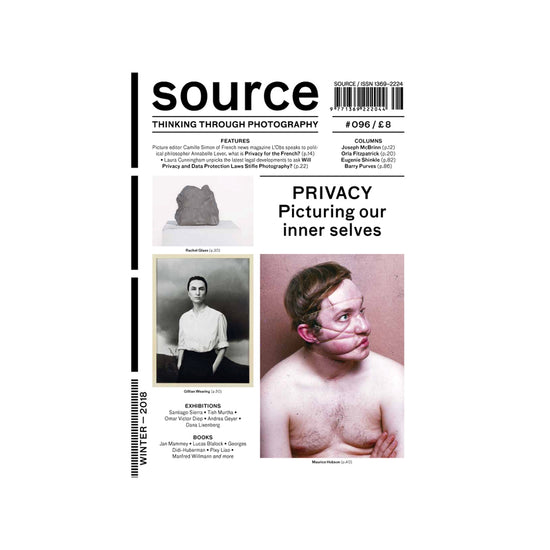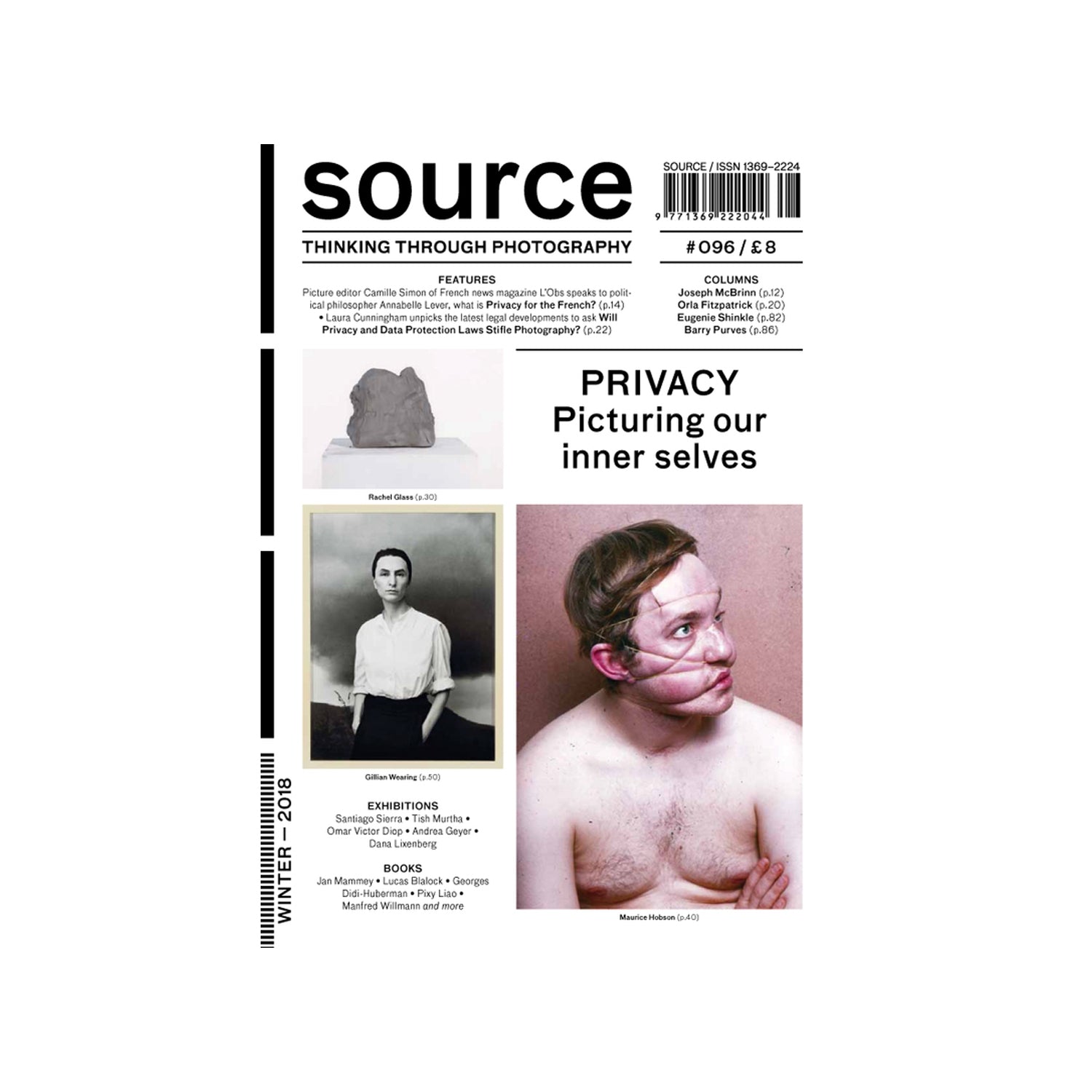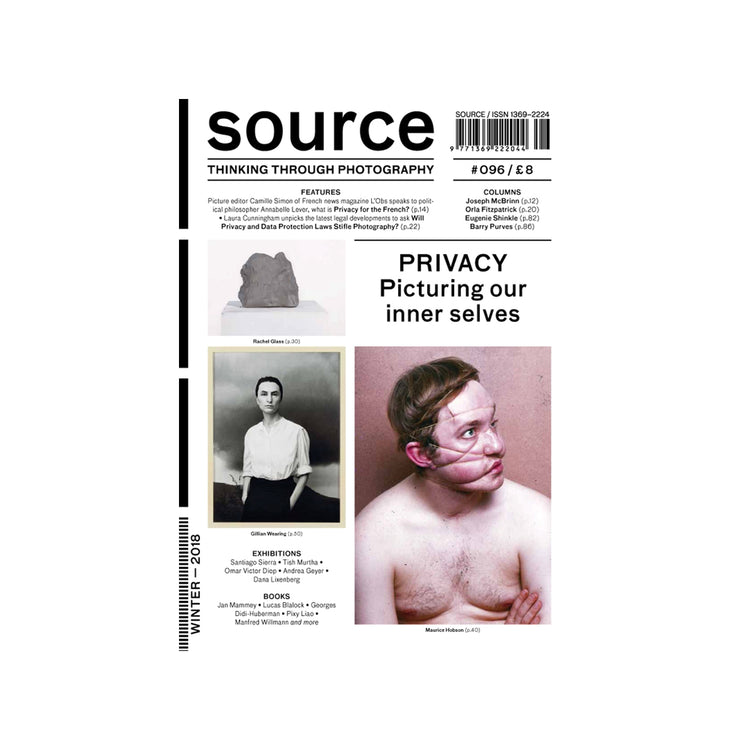Source 96 - Winter 2018
Description
More
Less
Issue 96 — Winter 2018
View Contents ▸
Privacy: Picturing our inner selves
A magazine about photography can encompass many of the most interesting aspects of contemporary life and that is what we have sought to connect with in renewing its design. You will find new columns about fashion, the afterlife of photographic objects and conversations with photographers, of all varieties, about their experience of the world. We maintain our commitment to reviewing exhibitions, books and anything else that defines the evolving photographic culture. We will continue to explore themes - like privacy in this issue - that seem particularly relevant to our current moment. Our attitude to photographs seems to encompass our contradictory feelings about privacy today. We are increasingly intolerant of being photographed in public but ever more willing to expose ourselves in photographs online. This has political, societal and legal consequences that are explored by our interview with Camille Simon and Laura Cunningham's article on the evolving law of privacy.
Rachel Glass's work came out of her experience of moving from Northern Ireland to London and not having a close network of family and friends to hand. This led into research on touch with a focus on the increasing sense of physical isolation experienced by many people. One antidote to this, which Glass photographed, are 'cuddle parties' which offer participants non-sexual physical intimacy. Glass explores how impactful touch can be on our inner world.
In this issue we have a new feature on overlooked archives of photography starting with the the work of Maurice Hobson. Hobson's work appeared as a single image in the 1988 issue of Creative Camera 'Photo Works from Northern Ireland' and in the catalogue for the exhibition at The Photographers' Gallery Image and Exploration Some Directions in British Photography 1980/85. Hobson died in 1987 from post-traumatic epilepsy, the long term consequence of being caught in an IRA bomb blast in 1975 on his way to school in Dungannon. Little of his work has been seen since his death but it recently resurfaced in a small exhibition organised by his family shown at the University of Atypical gallery in Belfast. The work presents a disturbing insight into the mental and physical anguish of someone dealing with being badly injured. Declan Long has been to look at the archive of his photographs, held by his family, to find out more about the photographer and his work.
In our retrospective feature on an established photographer we look back at the work of Gillian Wearing. Catherine Grant interviews Wearing beginning with her famous series from 1992-3, Signs that say what you want them to say and not Signs that say what someone else wants you to say which she remarks are 'a still-startling catalogue of the ways in which what people are thinking very rarely matches our impressions of them'. The interview goes on to look at Wearing's other work including the Family Album series and her most recent project Spiritual Family in which she has photographed herself as artists who have influenced and inspired her. Central to Wearing's output is the question of what it means to picture the self and how photographs define who we are.
We'd like to thank Rob and Carel from Studio Rob van Hoesel for their work on the redesign. We hope you enjoy it.
— The Editors
Description
Issue 96 — Winter 2018
View Contents ▸
Privacy: Picturing our inner selves
A magazine about photography can encompass many of the most interesting aspects of contemporary life and that is what we have sought to connect with in renewing its design. You will find new columns about fashion, the afterlife of photographic objects and conversations with photographers, of all varieties, about their experience of the world. We maintain our commitment to reviewing exhibitions, books and anything else that defines the evolving photographic culture. We will continue to explore themes - like privacy in this issue - that seem particularly relevant to our current moment. Our attitude to photographs seems to encompass our contradictory feelings about privacy today. We are increasingly intolerant of being photographed in public but ever more willing to expose ourselves in photographs online. This has political, societal and legal consequences that are explored by our interview with Camille Simon and Laura Cunningham's article on the evolving law of privacy.
Rachel Glass's work came out of her experience of moving from Northern Ireland to London and not having a close network of family and friends to hand. This led into research on touch with a focus on the increasing sense of physical isolation experienced by many people. One antidote to this, which Glass photographed, are 'cuddle parties' which offer participants non-sexual physical intimacy. Glass explores how impactful touch can be on our inner world.
In this issue we have a new feature on overlooked archives of photography starting with the the work of Maurice Hobson. Hobson's work appeared as a single image in the 1988 issue of Creative Camera 'Photo Works from Northern Ireland' and in the catalogue for the exhibition at The Photographers' Gallery Image and Exploration Some Directions in British Photography 1980/85. Hobson died in 1987 from post-traumatic epilepsy, the long term consequence of being caught in an IRA bomb blast in 1975 on his way to school in Dungannon. Little of his work has been seen since his death but it recently resurfaced in a small exhibition organised by his family shown at the University of Atypical gallery in Belfast. The work presents a disturbing insight into the mental and physical anguish of someone dealing with being badly injured. Declan Long has been to look at the archive of his photographs, held by his family, to find out more about the photographer and his work.
In our retrospective feature on an established photographer we look back at the work of Gillian Wearing. Catherine Grant interviews Wearing beginning with her famous series from 1992-3, Signs that say what you want them to say and not Signs that say what someone else wants you to say which she remarks are 'a still-startling catalogue of the ways in which what people are thinking very rarely matches our impressions of them'. The interview goes on to look at Wearing's other work including the Family Album series and her most recent project Spiritual Family in which she has photographed herself as artists who have influenced and inspired her. Central to Wearing's output is the question of what it means to picture the self and how photographs define who we are.
We'd like to thank Rob and Carel from Studio Rob van Hoesel for their work on the redesign. We hope you enjoy it.
— The Editors
You May Also Like





